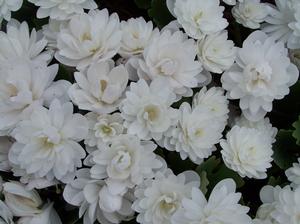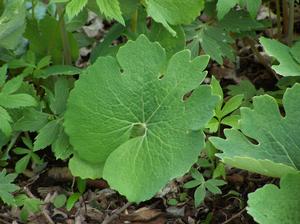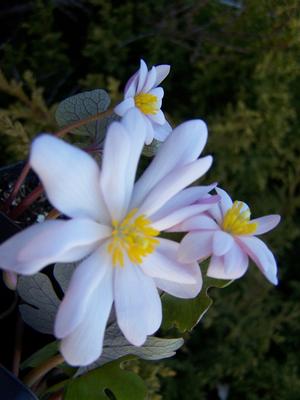
Sanguinaria canadensis 'Multiplex'

Bloodroot's typical summer leaf

Sanguinaria canadensis 'Pink Form' (maybe the same as 'Blush')
Sanguinaria canadensis - Bloodroot
Among my favorite shade perennials is Bloodroot. Sanguinaria canadensis is called Bloodroot because when you cut into the thick rootstock the color of the flesh and the juice that drips from it is reddish to red-orange. And contrary to the aversion the common name may instill Sanguinaria canadensis is one of our most beautiful native woodlanders.
As with many Eastern North America woodland plants the plants emerge in early spring, April at Quackin' Grass, where they take adavantage of the warm spring sun before the canopies of trees shade them. Each flower which emerges just prior to the foliage is a lovely 2-inch cupped daisy-like flower arising 3 to 5 inches tall. At the center of each flower is a golden honey complex of pistil and stamens. Flowers are ephemeral lasting but a week if temperatures remain cool. One blast of too-soon heat and the number of days the flowers display may decrease. But they are beautiful and an absolute joy. In that they are soon gone makes them all the more dear.
The leaves which follow and remain clean and green through the summer in good cultural conditions are bold and architecturally exceptional. Each rounded leaf can measure up to 6 inches across by 6 to 7 inches in length, boldly lobed with as many as seven fat "fingers". Sometimes a leaf will exhibit broad and gentle undulation. On occasion a leaf's lobes may be more deeply cut. Fascinating, the center lobe displays a frilly cock's comb at the tip, the crest extending the reach of the leaf as it augments interest. An established colony of bloodroot behaves as a ground cover growin 3 to 7 inches tall and is notably handsome in the summer garden Companions with finer leaves such as ferns, barrenworts (Epimedium) or, indeed, any softer-leaved perennial creates aesthetic dissonance and added beauty. In our minds Sanguinaria canadensis, in specie or any of the selected forms is essential in the processional of pagentry of the shady woodland realm.
Culture is easy. Fertile, moisture retaining to an average woodland soil is appropriate. Sanguinaria as with many eastern woodlanders is adapted to drier summer conditions. In a drier spot in a droughty summer or if planted in more sun the foliage may find dormancy sooner. This is a plant best suited to open or dappled shade where its amazing leaves can be appreciated all the growing season long. Bloodroot harbors broad potential to gardeners as it is bone hardy, from -40 to 10F, USDA climate zones 3 to 8.
Medicinally, Sanguinaria contains an alkaloid called Sanguinarine. Employed by Amerindians for stomach and respiratory problems it was also utilized topically to remove warts and even superficial tumors. Presently, it harbors therapeutic salience for prostate, breast and pancreatic cancers among others where it kills cancer cells without harming healthy tissue.
There is a growing roster of worthy selections, many still rare with new ones emerging every so often. 'Edith Dusek' is a Jerry Flintoff selection displaying much larger flowers than the species. It may also stretch to 10 inches tall which is stratospheric for Bloodroot. When in flower 'Edith Dusek' is much showier than its smaller flowering siblings. It is still rare in the trade.
'Tennessee Form' came our way from our friend, Maryanne Gryboski. This is an exceptionally strong and robust grower with big leaves and extra-large flowers. Sometimes the flowers exhibit a semi-double trait. Its genetic character extends to its quicker increase as well. Seed often comes true from this great plant. Another quite rare semi-double form is 'Betty Casto' which originated in West Virginia.
There are at least two or perhaps three pink forms, 'Armstrong Pink', 'Blush' and "pink form". It is entirely possilbe that 'Blush' and "pink form" are the very same plant. Pinkish buds emerge from the soil on all of these and open to single pink flowers which fade to white. All exhibit a deeper pink petal reverse than the pastel of the inner petals, the two-toned effect is lovely. A bonus is that the pink may extend into stems and emerging leaves as well. All pink forms are still rare and claim a hefty price tag. But for lovers of Sanguinaria and collectors of the rare it may be worth the cost.
'Multiplex' is very different from the typical daisy-like flowers of the others as it is a glorious and memorable double form in saturated homogenized milk-white. Originally espied by Guido von Webern in a recently purchased wild patch in Dayton, Ohio he marked, nurtured and finally shared his spectacular find. (We thank Jim McCaulley for sharing this bit of history with us.) 'Multiplex' demands attention in the April garden. A sterile plant, not producing seed and displays no sexual parts it is pure white with no other color present. Unless you merely let it go in the garden where it will very slowly increase its numbers this gorgeous form can only be reproduced by cutting pieces of the thick rhizome displaying "eyes". True with all forms tucked away within the eyes are next season's embryonic flowers and leaves. Propagation is best accomplished in the very late summer or early autumn.
Might you not consider Bloodroot, Sanguinaria canadensis, as an element in your woodland scheme? With beautiful flowers and exceptional leaves which last the summer in cool shade this choice woodlander is a keeper! And for native plant enthusiasts Bloodroot is mandatory. Dig in and have fun.
Penned by Wayne Paquette, September 2014